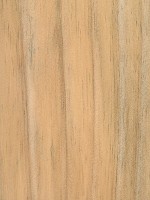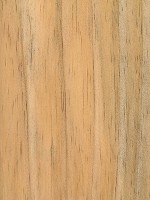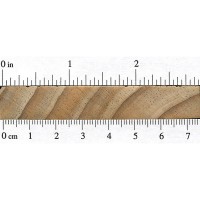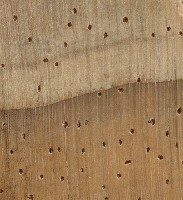 |
Common Name(s): Radiata Pine, Monterey Pine, Insignis Pine
Scientific Name: Pinus radiata Distribution: Native to central and southern coastal California; Tree Size: 80-100 ft (24-30 m) tall, 2-3 ft (.6-1m) trunk diameter Average Dried Weight: 32 lbs/ft3 (515 kg/m3) Specific Gravity (Basic, 12% MC): .41, .51 Janka Hardness: 710 lbf (3,150 N) Modulus of Rupture: 11,480 lbf/in2 (79.2 MPa) Elastic Modulus: 1,458,000 lbf/in2 (10.06 GPa) Crushing Strength: 6,030 lbf/in2 (41.6 MPa) Shrinkage:Radial: 3.4%, Tangential: 6.7%, Volumetric: 10.7%, T/R Ratio: 2.0 |
Color/Appearance: Heartwood is light brown, wide sapwood is a paler yellowish white, and is distinct from the heartwood. Radiata Pine lumber is plantation-grown, and generally has very wide growth rings and is knot-free.
Grain/Texture: Straight grained with a medium, even texture.
Endgrain: Medium-large resin canals, very numerous and evenly distributed, mostly solitary; earlywood to latewood transition gradual (with very wide growth rings), color contrast moderate to low; tracheid diameter medium-large.
Rot Resistance: The heartwood is rated as non-durable to perishable in regards to decay resistance. The sapwood is readily treated with preservatives and is used in exterior applications.
Workability: Radiata Pine works well with both hand and machine tools. Glues and finishes well.
Odor: Radiata Pine has a faint, resinous odor while being worked.
Allergies/Toxicity: Working with pine has been reported to cause allergic skin reactions and/or asthma-like symptoms in some people. See the articles Wood Allergies and Toxicity and Wood Dust Safety for more information.
Pricing/Availability: Radiata Pine is grown almost exclusively on plantations—most notably in Chile, Australia, and New Zealand. Prices should be moderate for an imported lumber, though most likely more expensive than domestic pines/softwoods.
Sustainability: This wood species is not listed in the CITES Appendices, but is reported by the IUCN as being conservation dependent. Cessation of any current conservation programs would likely result in a vulnerable or endangered Red List status. Although this tree is widely cultivated on plantations, natural stands of Radiata Pine are frequently infected by a fungal disease known as Pine Pitch Canker.
Common Uses: Veneer, plywood, paper (pulpwood), boxes/crates, and construction lumber.
Comments: In the southern hemisphere, where pines are to a large extent absent, Radiata Pine is the most commonly planted and cultivated pine. It is valued on plantations for its fast growth and utility as both a source of construction lumber as well as wood pulp in the paper industry.
- Austrian Pine (Pinus nigra)
- Caribbean Pine (Pinus caribaea)
- Eastern White Pine (Pinus strobus)
- Jack Pine (Pinus banksiana)
- Jeffrey Pine (Pinus jeffreyi)
- Khasi Pine (Pinus kesiya)
- Limber Pine (Pinus flexilis)
- Loblolly Pine (Pinus taeda)
- Lodgepole Pine (Pinus contorta)
- Longleaf Pine (Pinus palustris)
- Maritime Pine (Pinus pinaster)
- Ocote Pine (Pinus oocarpa)
- Patula Pine (Pinus patula)
- Pinyon Pine (Pinus edulis)
- Pitch Pine (Pinus rigida)
- Pond Pine (Pinus serotina)
- Ponderosa Pine (Pinus ponderosa)
- Red Pine (Pinus resinosa)
- Sand Pine (Pinus clausa)
- Scots Pine (Pinus sylvestris)
- Shortleaf Pine (Pinus echinata)
- Slash Pine (Pinus elliottii)
- Spruce Pine (Pinus glabra)
- Sugar Pine (Pinus lambertiana)
- Sumatran Pine (Pinus merkusii)
- Table Mountain Pine (Pinus pungens)
- Western White Pine (Pinus monticola)
- Virginia Pine (Pinus virginiana)
Scans/Pictures:
 |
 |
 |
 |





Radiata pine trunks can grow to over 3m in diameter.
This species can reach enormous sizes if not too crowded.
Can someone let me know the difference from Radiata Pine and Spruce?
1-Do we have any documents compare between them?
2-The Radiata Pine in NZ and Chile which one is better for quality?
Your help will be really appreciated. Thanks,
Hi All,
I wanted to know what exactly is this brown thing on the finished pallet made out of KD Radiata Pine Wood. Is it harmful? how it can be prevented? Why did it appear?
Your help will be really appreciated.
“Chocolate Tube Slime” https://en.wikipedia.org/wiki/Stemonitis
https://www.messiah.edu/Oakes/fungi_on_wood/club%20and%20coral/species%20pages/Stemonitis.htm
The images shown with the black specks throughout the wood does not look representative of the radiata pine in Australia and New Zealand. I think those black specks shown might be a fungal staining. The radiata pine I have seen in Australia is pale yellow/white to pale brown with no black. I think the suppliers here apply an fungicide treatment to the green logs before further processing to stop the fungal staining. This is separate from the treatments of the dried wood to produce “treated” pine for outdoor use, or for termite resistance of structural pine. Image attached is dressed… Read more »
Those black specs are actually resin canals, which are so large in pine species that they can usually be seen on flatsawn surfaces like the picture above. But you may be right in that there may be fungal discoloration of some sort that may serve to accentuate the resin canals. I’ll have to look into this a little more.
But I have attached a different photo of another specimen, this time of wild radiata pine (now considered “endangered” by IUCN) and it shows the same streaks — which are actually just the resin canals.
Hi Eric, I was not just talking about the streaks – as shown in your image – but also the pervasive dusting of black specs throughout the wood as shown in the four “Scans/Pictures” currently shown for this article. My description may be a bit off but I am trying to describe that mouldy (moldy) looking black stuff. I think that is mould (mold) or fungal infection and is considered a defect so it is perhaps not representative of radiata pine. Though it is apparently very common unless the green wood is dried quickly or treated with fungicide so perhaps… Read more »
I agree with Anthony, here in Chile, radiata pine is almost the only wood you can find in hardware stores and it looks nothing like the reference picture..you would be very hard pressed to find a piece free of knots or an even grain pattern, and resin canals are seldom present. Anthony’s pic is a much better representation of a premium slab of radiata
Radiata Pine is an awesome building material
Want to use primed radiata pine from home depot on my bbq island on top, directly exposed to the elements to the elements. What do you think? Need to know quickly, right now.
Only clear wood is knot free, carefully pruned and selected. That’s probably the only stuff that can be found in USA because otherwise it’s fairly low grade timber.
If you want to see radiata pine, just visit your local Home Depot. Their premium pine is radiata from New Zealand. It is completely clear of knots and is a delight to work with. The appearance is similar to yellow pines, but the texture is more like white pines, without the alternating hard and soft layers that yellow pine has. It looks great under a clear finish.
This article has many mistakes. Even glancing at it I was able to make out two; that radiata pine is knot free (very untrue; knots are very common) and that it has a medium and even texture (again, untrue; it has a fine texture and uneven grain which allows for more secure joints when using glue). I recommend looking into other sources.
Radiata Pine is MOSTLY knot free. Because they are plantation grown new growth limbs are trimmed away there may be tiny knots where the limbs were. And from my experience does not have a fine grain similar to that of maple, which most certainly is fine grained.